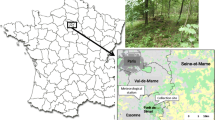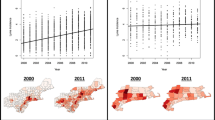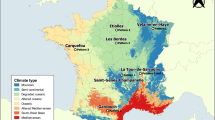Abstract
Research on the public health significance of Ixodes scapularis ticks in the Midwest seldom focuses on extreme weather conditions that can modulate their population dynamics and ability to transmit pathogenic organisms. In this study, we assessed whether the distributional abundance of I. scapularis immatures is associated with current and time-lagged climatic determinants either directly or indirectly. We analyzed a 20-year longitudinal small mammal live-trapping dataset within a seven-county metropolitan area in Minnesota (1998–2016) using yearly tick counts at each site to assess whether inter- and intra-annual variation in immature I. scapularis counts is associated with climate and land-use conditions. We found that (1) immature I. scapularis ticks infesting mammals expanded southwesterly over the study period, (2) eastern chipmunks, Tamias striatus, supplied a substantial proportion of nymphal blood meals, (3) a suite of climatological variables are demonstrably associated with I. scapularis presence, and abundance across sites, most notably summer vapor pressure deficit, and (4) immature I. scapularis display an affinity for deciduous forests in metro areas. Our results suggest that climatic and land-type conditions may impact host-seeking I. scapularis ticks through numerous mechanistic avenues. These findings extend our understanding of the abiotic factors supporting I. scapularis populations in metro areas of the upper Midwest with strong implications for discerning future tick-borne pathogen risk.


Similar content being viewed by others
References
Abatzoglou John T (2013) Development of Gridded Surface Meteorological Data for Ecological Applications and Modelling. International Journal of Climatology 33(1):121–131. https://doi.org/10.1002/joc.3413
Abatzoglou John T, Dobrowski Solomon Z, Parks Sean A, Hegewisch Katherine C (2018) TerraClimate, a High-Resolution Global Dataset of Monthly Climate and Climatic Water Balance from 1958–2015. Scientific Data 5(1):170191. https://doi.org/10.1038/sdata.2017.191
Adalsteinsson, Solny A., Vincent D'Amico, W. Gregory Shriver, Dustin Brisson, and Jeffrey J. Buler. 2016. "Scale‐dependent Effects of Nonnative Plant Invasion on Host‐seeking Tick Abundance." Edited by D. P. C. Peters. Ecosphere 7 (3). https://doi.org/10.1002/ecs2.1317.
Berger KA, Ginsberg HS, Gonzalez L, Mather TN (2014a) Relative Humidity and Activity Patterns of Ixodes Scapularis (Acari: Ixodidae). Journal of Medical Entomology 51(4):769–776. https://doi.org/10.1603/ME13186
Berger Kathryn A, Ginsberg Howard S, Dugas Katherine D, Hamel Lutz H, Mather Thomas N (2014b) Adverse Moisture Events Predict Seasonal Abundance of Lyme Disease Vector Ticks (Ixodes scapularis). Parasites & Vectors 7(1):181. https://doi.org/10.1186/1756-3305-7-181
Boehnke Denise, Gebhardt Reiner, Petney Trevor, Norra Stefan (2017) On the Complexity of Measuring Forests Microclimate and Interpreting Its Relevance in Habitat Ecology: The Example of Ixodes ricinus Ticks. Parasites & Vectors 10(1):549. https://doi.org/10.1186/s13071-017-2498-5
Brunner Jesse L, Killilea Mary, Ostfeld Richard S (2012) Overwintering Survival of Nymphal Ixodes scapularis (Acari: Ixodidae) Under Natural Conditions. Journal of Medical Entomology 49(5):981–987. https://doi.org/10.1603/ME12060
Brunner, Jesse L., Shannon L. LaDeau, Mary Killilea, Elizabeth Valentine, Megan Schierer, and Richard S. Ostfeld. 2023. “Off‐host Survival of Blacklegged Ticks in Eastern North America: A Multistage, Multiyear, Multisite Study.” Ecological Monographs, April, e1572. https://doi.org/10.1002/ecm.1572.
Burtis James C, Sullivan Patrick, Levi Taal, Oggenfuss Kelly, Fahey Timothy J, Ostfeld Richard S (2016) The Impact of Temperature and Precipitation on Blacklegged Tick Activity and Lyme Disease Incidence in Endemic and Emerging Regions. Parasites & Vectors 9(1):606. https://doi.org/10.1186/s13071-016-1894-6
Burtis James C, Fahey Timothy J, Yavitt Joseph B (2019a) Survival and Energy Use of Ixodes scapularis Nymphs throughout Their Overwintering Period. Parasitology 146(6):781–790. https://doi.org/10.1017/S0031182018002147
Burtis James C, Yavitt Joseph B, Fahey Timothy J, Ostfeld Richard S (2019b) “Ticks as Soil-Dwelling Arthropods: An Intersection Between Disease and Soil Ecology”. Edited by Howard Ginsberg. Journal of Medical Entomology 56(6):1555–1564. https://doi.org/10.1093/jme/tjz116
Burtis James C, Foster Erik, Schwartz Amy M, Kugeler Kiersten J, Maes Sarah E, Fleshman Amy C, Eisen Rebecca J (2022) Predicting Distributions of Blacklegged Ticks (Ixodes scapularis), Lyme Disease Spirochetes (Borrelia burgdorferi sensu stricto) and Human Lyme Disease Cases in the Eastern United States. Ticks and Tick-Borne Diseases 13(5):102000. https://doi.org/10.1016/j.ttbdis.2022.102000
Burtis, James C, Jenna Bjork, Tammi L Johnson, Elizabeth Schiffman, David Neitzel, and Rebecca J Eisen. 2023. "Seasonal Activity Patterns of Host-Seeking Ixodes scapularis (Acari: Ixodidae) in Minnesota, 2015–2017." Edited by Maria Diuk-Wasser. Journal of Medical Entomology, April, tjad048. https://doi.org/10.1093/jme/tjad048.
CDC. 2021. "How Many People Get Lyme Disease?" January 13, 2021. https://www.cdc.gov/lyme/stats/humancases.html.
Clow Katie M, Ogden Nicholas H, Robbin Lindsay L, Michel Pascal, Pearl David L, Jardine Claire M (2017) The Influence of Abiotic and Biotic Factors on the Invasion of Ixodes scapularis in Ontario, Canada. Ticks and Tick-Borne Diseases 8(4):554–563. https://doi.org/10.1016/j.ttbdis.2017.03.003
Division, Virginia Polytechnic Institute Research, and D.E. Sonenshine. 1979. Insects of Virginia; No. 13 Ticks of Virginia (Acari: Metastigmata.). Research Division Bulletin. https://books.google.com/books?id=\_JhEYAAACAAJ
Dumas Ariane, Catherine Bouchard L, Lindsay Robbin, Ogden Nicholas H, Leighton Patrick A (2022) Fine-Scale Determinants of the Spatiotemporal Distribution of Ixodes scapularis in Quebec (Canada). Ticks and Tick-Borne Diseases 13(1):101833. https://doi.org/10.1016/j.ttbdis.2021.101833
Daniel E. Sonenshine and R. Michael Roe. 2014. Biology of Ticks. Second. Vol. 1. 3. Oxford University Press.
Eisen Rebecca J, Eisen Lars (2018) The Blacklegged Tick, Ixodes scapularis: An Increasing Public Health Concern. Trends in Parasitology 34(4):295–309. https://doi.org/10.1016/j.pt.2017.12.006
Eisen Rebecca J, Eisen Lars, Beard Charles B (2016) County-Scale Distribution of Ixodes scapularis and Ixodes pacificus (Acari: Ixodidae) in the Continental United States. Journal of Medical Entomology 53(2):349–386. https://doi.org/10.1093/jme/tjv237
Ginsberg Howard S, Rulison Eric L, Miller Jasmine L, Pang Genevieve, Arsnoe Isis M, Hickling Graham J, Ogden Nicholas H, LeBrun Roger A, Tsao Jean I (2020) Local Abundance of Ixodes scapularis in Forests: Effects of Environmental Moisture, Vegetation Characteristics, and Host Abundance. Ticks and Tick-Borne Diseases 11(1):101271. https://doi.org/10.1016/j.ttbdis.2019.101271
Hassett Erin M, Thangamani Saravanan (2021) Ecology of Powassan Virus in the United States. Microorganisms 9(11):2317. https://doi.org/10.3390/microorganisms9112317
Hayes Laura E, Scott Jennifer A, Stafford Kirby C (2015) Influences of Weather on Ixodes scapularis Nymphal Densities at Long-Term Study Sites in Connecticut. Ticks and Tick-Borne Diseases 6(3):258–266. https://doi.org/10.1016/j.ttbdis.2015.01.006
Hazard Evan (1982) Mammals of Minnesota. First: University of Minnesota Press
Johnson TL, Bjork JKH, Neitzel DF, Dorr FM, Schiffman EK, Eisen RJ (2016) Habitat Suitability Model for the Distribution of Ixodes scapularis (Acari: Ixodidae) in Minnesota. Journal of Medical Entomology 53(3):598–606. https://doi.org/10.1093/jme/tjw008
Jones, J. Knox Jr., and Elmer C. Birney. 1988. Handbook of Mammals of the North-Central States.
Keirans James E, Litwak Taina R (1989) Pictorial Key to the Adults of Hard Ticks, Family Ixodidae (Ixodida: Ixodoidea), East of the Mississippi River. Journal of Medical Entomology 26(5):435–448. https://doi.org/10.1093/jmedent/26.5.435
Khatchikian Camilo E, Prusinski Melissa, Melissa Stone P, Backenson Bryon, Wang Ing-Nang, Levy Michael Z, Brisson Dustin (2012) Geographical and Environmental Factors Driving the Increase in the Lyme Disease Vector Ixodes scapularis. Ecosphere 3(10):art85. https://doi.org/10.1890/ES12-00134.1
Kilpatrick A. Marm, Dobson Andrew D. M, Levi Taal, Salkeld Daniel J, Swei Andrea, Ginsberg Howard S, Kjemtrup Anne et al (2017) Lyme Disease Ecology in a Changing World: Consensus, Uncertainty and Critical Gaps for Improving Control. Philosophical Transactions of the Royal Society B: Biological Sciences 372(1722):20160117. https://doi.org/10.1098/rstb.2016.0117
Linske Megan A, Williams Scott C, Stafford Kirby C, Ortega Isaac M (2018) Ixodes scapularis (Acari: Ixodidae) Reservoir Host Diversity and Abundance Impacts on Dilution of Borrelia burgdorferi (Spirochaetales: Spirochaetaceae) in Residential and Woodland Habitats in Connecticut, United States. Journal of Medical Entomology 55(3):681–690. https://doi.org/10.1093/jme/tjx237
Linske Megan A, Stafford Kirby C, Williams Scott C, Lubelczyk Charles B, Welch Margret, Henderson Elizabeth F (2019) Impacts of Deciduous Leaf Litter and Snow Presence on Nymphal Ixodes scapularis (Acari: Ixodidae) Overwintering Survival in Coastal New England, USA. InSects 10(8):227. https://doi.org/10.3390/insects10080227
Mathisson Daniel C, Kross Sara M, Palmer Matthew I, Diuk-Wasser Maria A (2021) “Effect of Vegetation on the Abundance of Tick Vectors in the Northeastern United States: A Review of the Literature”. Edited by Howard Ginsberg. Journal of Medical Entomology 58(6):2030–2037. https://doi.org/10.1093/jme/tjab098
McClure Max, Diuk-Wasser Maria A (2019) Climate Impacts on Blacklegged Tick Host-Seeking Behavior. International Journal for Parasitology 49(1):37–47. https://doi.org/10.1016/j.ijpara.2018.08.005
MDH. 2021. "High Risk Areas for Tick-borne Diseases in Minnesota." August 2021. https://www.health.state.mn.us/diseases/lyme/highrisk.html.
Minnesota Department of Natural Resources. 2022a. "Annual Canopy Cover (1973–2018) in Minnesota." Minnesota Geospatial Commons. July 1, 2022. https://gisdata.mn.gov/dataset/env-annual-canopy-cover.
Minnesota Department of Natural Resources. 2022b. “NLCD 2016 Land Cover, Minnesota.” Minnesota Geospatial Commons. July 1, 2022. https://gisdata.mn.gov/dataset/activity/biota-landcover-nlcd-mn-2016.
MDH. 2022. "Lyme Disease Statistics." Minnesota Department of Health. Accessed November 14, 2022. https://www.health.state.mn.us/diseases/lyme/statistics.html.
Needham GR, Teel PD (1991) Off-Host Physiological Ecology of Ixodid Ticks. Annual Review of Entomology 36(1):659–681. https://doi.org/10.1146/annurev.en.36.010191.003303
Nelson Christina A, Saha Shubhayu, Kugeler Kiersten J, Delorey Mark J, Shankar Manjunath B, Hinckley Alison F, Mead Paul S (2015) Incidence of Clinician-Diagnosed Lyme Disease, United States, 2005–2010. Emerging Infectious Diseases 21(9):1625–1631. https://doi.org/10.3201/eid2109.150417
Nuttall Pat (ed) (2021) Climate, Ticks and Disease. Boston: CAB International
R Core Team. 2022. R: A Language and Environment for Statistical Computing. Vienna, Austria: R Foundation for Statistical Computing. http://www.R-project.org/.
Randolph Sarah E, Storey Katie (1999) Impact of Microclimate on Immature Tick-Rodent Host Interactions (Acari: Ixodidae): Implications for Parasite Transmission. Journal of Medical Entomology 36(6):741–748. https://doi.org/10.1093/jmedent/36.6.741
Rosenberg Ronald, Lindsey Nicole P, Fischer Marc, Gregory Christopher J, Hinckley Alison F, Mead Paul S, Paz-Bailey Gabriela et al (2018) Vital Signs : Trends in Reported Vectorborne Disease Cases — United States and Territories, 2004–2016. MMWR Morbidity and Mortality Weekly Report 67(17):496–501. https://doi.org/10.15585/mmwr.mm6717e1
Schulze Terry L, Jordan Robert A (2022) “Daily Variation in Sampled Densities of Ixodes scapularis and Amblyomma americanum (Acari: Ixodidae) Nymphs at a Single Site—Implications for Assessing Acarological Risk”. Edited by Stephen Rich. Journal of Medical Entomology 59(2):741–751. https://doi.org/10.1093/jme/tjab213
Siy Patricia N, Larson Ryan T, Zembsch Tela E, Lee Xia, Paskewitz Susan M (2021) “High Prevalence of Borrelia mayonii (Spirochaetales: Spirochaetaceae) in Field-Caught Tamias striatus (Rodentia: Sciuridae) From Northern Wisconsin”. Edited by Sarah Hamer. Journal of Medical Entomology 58(6):2504–2507. https://doi.org/10.1093/jme/tjab102
Stafford Kirby C (1994) Survival of Immature Ixodes scapularis (Acari: Ixodidae) at Different Relative Humidities. Journal of Medical Entomology 31(2):310–314. https://doi.org/10.1093/jmedent/31.2.310
Talbot Benoit, Slatculescu Andreea, Thickstun Charles R, Koffi Jules K, Leighton Patrick A, McKay Roman, Kulkarni Manisha A (2019) Landscape Determinants of Density of Blacklegged Ticks, Vectors of Lyme Disease, at the Northern Edge of Their Distribution in Canada. Scientific Reports 9(1):16652. https://doi.org/10.1038/s41598-019-50858-x
Thomas Christina E, Burton Emily S, Brunner Jesse L (2020) “Environmental Drivers of Questing Activity of Juvenile Black-Legged Ticks (Acari: Ixodidae): Temperature, Desiccation Risk, and Diel Cycles”. Edited by Janet Foley. Journal of Medical Entomology 57(1):8–16. https://doi.org/10.1093/jme/tjz126
Volk Michelle R, Lubelczyk Charles B, Johnston Jason C, Levesque Danielle L, Gardner Allison M (2022) Microclimate Conditions Alter Ixodes scapularis (Acari: Ixodidae) Overwinter Survival across Climate Gradients in Maine, United States. Ticks and Tick-Borne Diseases 13(1):101872. https://doi.org/10.1016/j.ttbdis.2021.101872
Vuong, Quang H. (1989). Likelihood Ratio Tests for Model Selection and Non-Nested Hypotheses. Econometrica 57(2):307–333. https://doi.org/10.2307/1912557
Acknowledgements
The authors thank the Metropolitan Mosquito Control District for their sampling efforts and willingness to provide the data source.
Author information
Authors and Affiliations
Corresponding author
Supplementary Information
Below is the link to the electronic supplementary material.
Rights and permissions
Springer Nature or its licensor (e.g. a society or other partner) holds exclusive rights to this article under a publishing agreement with the author(s) or other rightsholder(s); author self-archiving of the accepted manuscript version of this article is solely governed by the terms of such publishing agreement and applicable law.
About this article
Cite this article
Cassens, J., Jarnefeld, J., Berman, J.D. et al. Environmental Drivers of Immature Ixodes scapularis in Minnesota’s Metro Area. EcoHealth 20, 273–285 (2023). https://doi.org/10.1007/s10393-023-01656-5
Received:
Revised:
Accepted:
Published:
Issue Date:
DOI: https://doi.org/10.1007/s10393-023-01656-5




